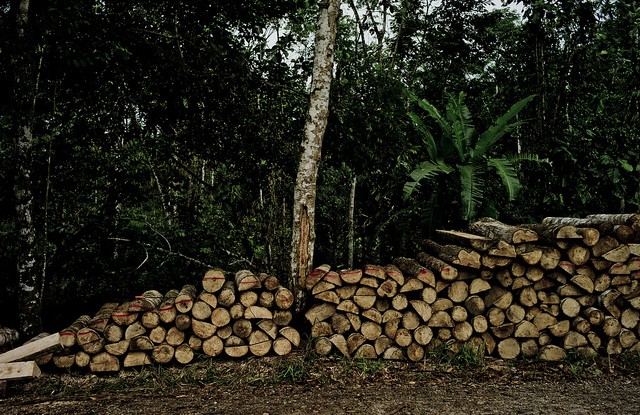
BOGOR, Indonesia (19 July, 2013) — Studies about the impact of logging on biodiversity in tropical regions should be scrutinized, conclusions toned down or even discounted, according to a recent publication in the journal “Conservation Biology“ that has revealed widespread methodological flaws.
Douglas Sheil, senior associate with the Center for International Forestry Research (CIFOR) Forests and Environment Programme and a collaborator on “Pseudoreplication in tropical forests and the resulting effects on biodiversity conservation“, said his team set out to determine why research about the impact of logging on tropical forest ecosystems often yields contradictory results.
In rainforest-specific studies, they found, scientists often treat sites that have been logged and those that haven’t as if they were identical before the timber cutting, and perform statistical comparisons that cannot support the conclusions that are drawn from them, an example of a methodological flaw known as “pseudoreplication”.
In many cases, the importance of local variations among study sites has been ignored while interpreting the research – so that all the differences, including those that were natural, are ascribed to timber cutting and removal.
As a result of the flawed interpretation, changes resulting from logging have often been exaggerated, Sheil said.
“Confronting pseudoreplication is essential for accurately assessing biodiversity in logged forests, identifying the relative merits of specific management practices and landscape configurations, and effectively balancing conservation with timber production in tropical forest landscapes,” he added.
Forest biodiversity is threatened by deforestation and forest degradation, hunting and the introduction of invasive species from other habitats. At least 13 million hectares (50,000 sq miles) of forest – an area almost the size of Nicaragua — are disappearing each year, according to the U.N. Food and Agriculture Organization.
Of 77 studies analyzed, only five were definitively free of pseudoreplication, said lead author Benjamin Ramage, a postdoctoral researcher at the University of California Berkeley.
“Methodological problems and pitfalls are much more prevalent than we had anticipated,” he said.
“We may need to discard some past results, while in some other cases, we may be able to estimate the corrections.”
The potential for statistical inaccuracies in forest assessment calls into question the results of an untold number of studies, as well as some established “truths” derived from literature that appears now to be “rife with unwarranted inferences,” the paper said.
Sheil said researchers sometimes use short cuts to compile data on species affected by logging, either due to lack of funding or to make results look more impressive.
“Rainforest studies are difficult to do well, and often there is a lot of pressure to make strong claims based on studies where budgets are constrained,” he said.
“We are used to saying ‘some information is better than none.’ But, of course, this is true only if we do not allow ourselves to be misled.”
The knock-on effects of the team’s findings could be huge.
With opinions already divided over whether well-managed logging areas are a positive step for the conservation of biodiversity, the new results are likely to rekindle the various debates on when and where timber production should be viewed as a friend or a foe to conservation.
It also has the potential to change the way we think about production forests which — unlike many other land-uses, such as oil palm and sugar cane — support a much higher level of forest species.
For the moment, Sheil said, researchers have little choice but to return to square one.
“If we don’t recognize and address the problem of pseudoreplication, we cannot accurately assess biodiversity in logged forests,” he said.
“There is also no way of knowing how to effectively balance conservation with timber production in tropical forests.”
“And how can we possibly say which management practices are effective and which are not.”
Both authors emphasized that their analyses should not be read as denying that logging has negative impacts on biodiversity. “We underline that some of these effects are real and justify concern,” Sheil said. “But it appears that many past results are unsound and likely to have been exaggerated. We would all be better able to focus our concerns and efforts if we had a more reliable knowledge of these logging effects.”
The prevalence of pseudoreplication in tropical forestry research, meanwhile, begs the question of how so many scientists failed to spot it in the first place. According to Sheil, it is all about awareness.
“It is about recognizing the problem and knowing why it matters. If researchers recognize when and where these approaches lead to problems we can avoid them,” he said.
Ramage says he hopes the report will encourage researchers to start thinking more critically about the conclusions they draw from their data and try to find ways to correctly replicate logging treatments.
For more information on the subjects discussed in this article, please contact Douglas Sheil at d.sheil@cgiar.org
This study was supported by the Global Environment Facility through the U.N. Development Programme Malaysia and the International Tropical Timber Organization. In-kind financial assistance and support was provided by the government of Malaysia through the Ministry of Natural Resources and Environment and the Forest Research Institute Malaysia. It was also supported by the CGIAR Research Program on Forests, Trees and Agroforestry.
We want you to share Forests News content, which is licensed under Creative Commons Attribution-NonCommercial-ShareAlike 4.0 International (CC BY-NC-SA 4.0). This means you are free to redistribute our material for non-commercial purposes. All we ask is that you give Forests News appropriate credit and link to the original Forests News content, indicate if changes were made, and distribute your contributions under the same Creative Commons license. You must notify Forests News if you repost, reprint or reuse our materials by contacting forestsnews@cifor-icraf.org.